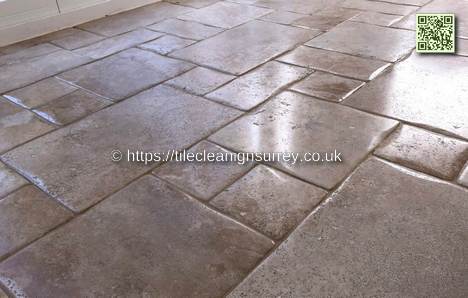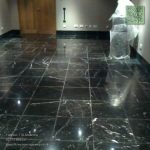This case study showcases the restoration of travertine tiles in high-traffic areas of a property in Chessington, Surrey. As the years passed, the once-beautiful travertine had lost its luster, becoming dull, stained, and worn. To restore its original elegance, we undertook a comprehensive project that included deep cleaning, filling natural holes, and applying a protective sealant. The result was a beautifully revitalized, low-maintenance floor that regained its natural charm and received long-lasting protection for future durability.
Travertine Floor Cleaning In Chessington – Key Points
- Thorough Cleaning is Crucial: A rotary scrubbing machine, heavy-duty travertine cleaners, and hot water pressurized rinse equipment remove ingrained soil that regular mopping can't tackle.
- Filling Holes Enhances Appearance and Durability: Addressing natural holes in the travertine improves its look and prevents future damage, ensuring the stone's longevity.
- Sealing Simplifies Maintenance: A properly applied sealer acts as a protective barrier, making future cleaning easier and preventing stains from setting in.
- Consistent Maintenance is Essential: A regular maintenance routine, including periodic resealing, keeps the travertine pristine and preserves its beauty for years.
Client Background:
This project focused on restoring travertine tiles in a Chessington home, where the kitchen, hallway, and w/c floors had suffered significant wear over the years. The homeowner sought a solution to bring back the natural beauty of the travertine while ensuring the floors would be easy to maintain and durable enough to withstand daily use. The restoration process involved deep cleaning, filling natural holes, and applying a protective sealant to achieve a clean, resilient surface that highlights the rich colors of the travertine.
 Project Background:
Project Background:
The travertine tiles, admired for their natural beauty and durability, had been in place for over a decade. Over time, the tiles lost their smooth finish, with soil accumulating in the pits and voids. The grout was discoloured, diminishing the floor's overall look. The project involved deep cleaning the tiles, filling the natural holes, and applying a protective sealer to restore the floor's appearance and enhance its long-term resilience.
Challenges Encountered During the Project
- Deeply Embedded Dirt: Years of foot traffic had caused dirt to become ingrained in the natural pits and voids of the travertine, making it difficult to clean with standard methods.
- Natural Holes: Travertine tiles' inherent holes and gaps trap the dirt and add to the floor's worn appearance.
- Stained Grout: Over time, the grout between the tiles had become heavily stained, further diminishing the floor's visual appeal.
- High Traffic Areas: The constant use of these spaces required a restoration approach that effectively revitalized the floor while minimizing disruption to the household.
Solution and Process:
Step 1: Assessment and Planning
The initial assessment identified the level of soiling and wear on the travertine tiles. Based on these findings, a plan was crafted to remove the ingrained dirt, fill the natural holes, and apply a protective sealer to restore the tiles and improve their durability.
Step 2: Cleaning Process
We prepared the work area by removing small pieces of furniture and clearing loose debris with brushing and vacuuming. After applying a diluted travertine cleaner and letting it soak for ten minutes, we used a rotary scrubbing machine with a medium-grade brush to remove the surface soil. We used hot-water rinse and capture equipment to tackle the dirt trapped in the holes and pits, effectively lifting the remaining soils and restoring the travertine’s clean surface.
Step 3: Filling Natural Holes
Step 4: Sealing the Floor
We applied a hybrid satin finish sealer with a roller, creating a mid-sheen look. This sealant formed a protective barrier against stains and dirt, making the floor easier to maintain. We ensured full coverage and a consistent finish during the sealing process.
Project Timeline:
We completed the project in two days, from assessment to final touches.
Project Results:
We restored the travertine to its original finish by removing ingrained soil and stains, revealing the natural colours of the tiles. The client expressed her delight with the results, commenting that the floor “looked as good as new”. The protective sealer now keeps the travertine low-maintenance and durable, preserving its beauty and functionality for the long term. This project turned a dull, worn floor into a revitalized, stunning surface.
Conclusion:
This travertine cleaning project in Chessington restored the tiles' natural beauty, making them a durable and low-maintenance flooring solution for the homeowner. We significantly enhanced the floor’s appearance and extended its longevity through deep cleaning, precise filling, and effective sealing. This case study highlights the value of professional cleaning and maintenance for natural stone surfaces like travertine.
If your travertine floor needs cleaning or restoration, contact us today for a consultation. Our expert services will keep your natural stone surfaces beautiful and functional for years to come.
Frequently Asked Questions
How Long Does the Travertine Cleaning Process Take?
The travertine cleaning usually takes several hours, depending on the floor’s condition. Thorough cleaning techniques remove ingrained soil and prepare the tiles for sealing, which helps prolong their lifespan.
Is It Safe to Use DIY Cleaning Products on Travertine?
Homemade cleaning solutions on travertine can be risky due to potential chemical reactions that may harm the stone. For this reason, it’s safer to use pH-balanced cleaners specifically designed for natural stone to ensure effective and safe cleaning.
Can Travertine Floors Be Installed Over Existing Tile?
Yes, travertine floors can be installed over existing tiles. Proper installation requires assessing the underlying surface and potentially levelling it to ensure a stable, long-lasting finish.
What Is the Cost Range for Travertine Floor Cleaning Services?
The cost of travertine floor cleaning services typically ranges from £3 to £5 per square foot. The price varies depending on the cleaning methods, soiling, and the condition of the tiles.
How Often Should Travertine Floors Be Professionally Cleaned?
Travertine floors should be professionally cleaned every 12 to 18 months. Regular maintenance, including prompt spill management and periodic sealing, will help preserve the stone’s natural beauty and longevity.
The post Travertine Floor Cleaning In Chessington Surrey. Sponsored by: Travertine Cleaning Chessington
The Article Reviving Travertine Floors in Chessington, Surrey appeared first on https://fabritec.org
The Article Reviving Travertine Floors in Chessington, Surrey Was Found On https://limitsofstrategy.com


It’s fascinating to read about the restoration of travertine tiles, especially since they have such a rich history and a unique aesthetic appeal. I’ve always admired how natural stone can add a touch of sophistication to any space, but I hadn’t realized just how much maintenance goes into keeping it looking pristine in high-traffic areas.
Your detailed account of the travertine restoration process in Chessington really highlights the fine balance between beauty and functionality that natural stone provides in our homes. It’s fascinating how something that was once a point of pride can turn into a challenge over time, especially in high-traffic areas where wear and tear are inevitable. The extensive cleaning methods you mentioned, particularly the use of a rotary scrubbing machine, truly emphasize the importance of professional care. It’s a reminder that sometimes, maintaining the beauty of our spaces requires a little extra effort and expertise that standard cleaning merely can’t provide.
You’ve captured the essence of maintaining natural stone beautifully. It’s surprising how much a well-maintained surface can elevate a space, especially with something like travertine that adds both warmth and elegance. I’ve found that the balance between beauty and functionality often reflects our own lives—in many ways, we’re all trying to preserve the things we love while managing the inevitable wear and tear of daily life.
I just came across a helpful piece on cleaning and sealing travertine floors that dives into the importance of proper care, which really resonates with the challenges you’ve mentioned in maintaining our beautiful stone surfaces.
‘Cleaning and Sealing a Travertine Floor in Chertsey, Surrey’
https://soonrs.com/cleaning-and-sealing-a-travertine-floor-in-chertsey-surrey/.
You’ve pointed out something really important about the nature of materials like travertine in our homes. It’s true that what we love about natural stone—its unique beauty and character—can also make it tricky to maintain, especially in busy areas. The challenge of wear and tear is a reality many homeowners face, but it’s encouraging to think of the restoration process as not just a chore, but a way to revitalize that connection to our living spaces.
It’s impressive to see how effectively restorative techniques can bring back the appeal of travertine tiles, especially in high-traffic areas. This case in Chessington really highlights the importance of thorough cleaning methods that go beyond standard upkeep. I’ve noticed that many property owners underestimate the benefits of addressing natural imperfections in stone flooring.